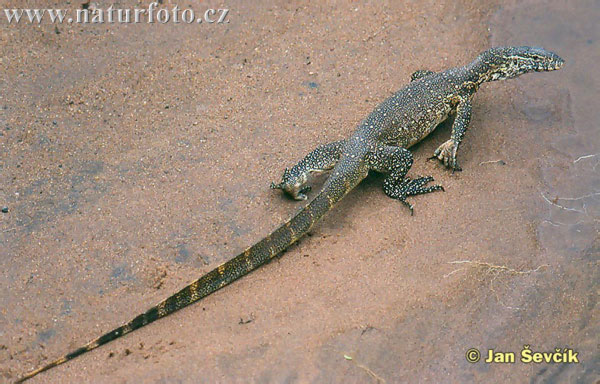I saw a television show the other day that seemed to focus on catching problem species in Florida. When I thought of invasive species in Florida the only animals I thought of were Pythons, Boas, and Tegus. However, I had never heard that the Nile Monitor Lizard was also in this category. A woman on the show appeared be very disappointed to hear that the unknown lizard that she had to catch turned out to be a Nile Monitor Lizard. It turns out that these are a dangerous and large lizard species that are invading Florida. So for this blog, I decided to look into this problem some more.
First, I wanted to read some general information about the species. The Nile Monitor Lizard (Varanus niloticus) is a large, semi-aquatic, carnivorous lizard in the Family Varanidae. Apparently, these lizards can attain a size of 5 to 7 feet long! For a lizard that can be up to seven feet long I was surprised to read that they may only weigh twenty pounds, it just seemed light to me. However, these slender'ish' lizards are very strong. Perhaps the streamline bodies are part of the reason they are also excellent swimmers. They can also hold their breath for up to an hour under the water. Along with being great swimmers the Nile Monitor Lizard can also move quickly on land and climb trees. They have razor sharp claws and teeth and can use their tail as a whip. These lizards are active hunters and will include in their diet: any animal it can fit in its mouth. Yes, that's correct. They will eat any organism, from land to water species that they can catch and eat, with eggs being a favorite.
An online search of 'Nile Monitor Invasive Species' quickly resulted in many online news articles regarding this species in Florida. The article I read, Nile Monitor Lizards: Invasive Species in Florida Threatens Native Species, cited that the first breeding population of Nile Monitor Lizards was found in the Florida wild in 1990. The story with the release of this lizard sounded the same as the other invasive Florida species I knew of - they were taken from their native habitat (South and Central Africa), sold as pets, these pets escaped or were released because they got too big (seven feet!), they adapted well to Florida's habitat, bred, and BOOM! - another explosive invasive species problem. The problem with these lizards is that they prey on many different animals of Florida, can breed quickly, and have few predators. Due to the fact that these lizards love to prey on eggs and young of turtles, birds, and alligators, Florida species, even endangered ones, should be concerned. Also, Florida, and other southeastern states should be worried because of their adaptability and the fact that females can lay approximately sixty eggs yearly. The lizards provide no parental care and lay eggs in nests near water. They also seem to have only two predators, pythons and crocodiles. I feel that these predators can most certainly not keep the population of the lizards down. Perhaps what should happen is scientists do very little research and put very little thought into introducing a non-native species into Florida that will prey on the lizards to keep the population in check....just kidding.
What really concerns me is the possibility for the lizards to spread far beyond the Florida area. We all know Florida has a serious non-native species problem. I hope they can find a way to work out that problem, but I really hope the animals can't spread any further. After learning a little about these Nile Monitors, I worry that they could spread through Georgia and possibly into South Carolina. Oh and also, I forget to mention they are burrowers. They can burrow during the winter and hibernate as to avoid the cold, waiting for the warm months to come around. I would hate to have to worry about Nile Monitor lizards roaming around wetland or dry areas of South Carolina and snatching up small cats and dogs. Hopefully this won't happen. Luckily, and I did not know this, Florida has an "Exotic Pet Amnesty Program." On certain days, people are allowed to turn over their exotic pets without any punishments brought upon them. Also, it is illegal to set any exotic animal free in Florida. With these and other efforts, the population of the Nile Monitor lizard will hopefully be kept in check.
I'm glad to have learned a little bit about these lizards that I knew nothing of. I would like to wish luck to any and all Florida residents and/or cats, dogs, and small humans living in Florida, and to those that are devising plans to reduce the invasive species populations in the area.
For a size reference, yeah that's a big lizard

Wetzel, D.R. Decoded Sciene: Nile Monitor Lizards: Invasive Species in Florida Threatens Native Species. http://www.decodedscience.com/nile-monitor-lizards-invasive-species-in-florida-threatens-native-species/1962/2
http://www.oregonzoo.org/discover/animals/nile-monitor-lizard
Florida Wildlife Conservation : http://myfwc.com/nonnatives
http://myfwc.com/wildlifehabitats/nonnatives/reptiles/nile-monitor/
http://www.oregonzoo.org/discover/animals/nile-monitor-lizard
Florida Wildlife Conservation : http://myfwc.com/nonnatives
http://myfwc.com/wildlifehabitats/nonnatives/reptiles/nile-monitor/


1 comment:
Wow. Should we hope that the invasive pythons eat the monitors or that the monitors get the pythons' eggs?
Post a Comment